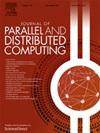Efficient parameter tuning for a structure-based virtual screening HPC application
IF 3.4
3区 计算机科学
Q1 COMPUTER SCIENCE, THEORY & METHODS
引用次数: 0
Abstract
Virtual screening applications are highly parameterized to optimize the balance between quality and execution performance. While output quality is critical, the entire screening process must be completed within a reasonable time. In fact, a slight reduction in output accuracy may be acceptable when dealing with large datasets. Finding the optimal quality-throughput trade-off depends on the specific HPC system used and should be re-evaluated with each new deployment or significant code update. This paper presents two parallel autotuning techniques for constrained optimization in distributed High-Performance Computing (HPC) environments. These techniques extend sequential Bayesian Optimization (BO) with two parallel asynchronous approaches, and they integrate predictions from Machine Learning (ML) models to help comply with constraints. Our target application is LiGen, a real-world virtual screening software for drug discovery. The proposed methods address two relevant challenges: efficient exploration of the parameter space and performance measurement using domain-specific metrics and procedures. We conduct an experimental campaign comparing the two methods with a popular state-of-the-art autotuner. Results show that our methods find configurations that are, on average, up to 35–42% better than the ones found by the autotuner and the default expert-picked LiGen configuration.
基于结构的虚拟筛选HPC应用程序的有效参数调整
虚拟筛选应用程序高度参数化,以优化质量和执行性能之间的平衡。虽然输出质量至关重要,但整个筛选过程必须在合理的时间内完成。事实上,在处理大型数据集时,输出精度的轻微降低是可以接受的。找到最佳的质量-吞吐量权衡取决于所使用的特定HPC系统,并且应该在每次新的部署或重要的代码更新时重新评估。本文提出了分布式高性能计算(HPC)环境下约束优化的两种并行自调优技术。这些技术通过两种并行异步方法扩展了顺序贝叶斯优化(BO),并集成了机器学习(ML)模型的预测,以帮助遵守约束。我们的目标应用程序是LiGen,一个用于药物发现的现实世界虚拟筛选软件。提出的方法解决了两个相关的挑战:有效地探索参数空间和使用特定领域的度量和程序进行性能测量。我们进行了一项实验活动,将这两种方法与流行的最先进的自动调谐器进行比较。结果表明,我们的方法发现的配置平均比自动调谐器和默认专家选择的LiGen配置发现的配置好35-42%。
本文章由计算机程序翻译,如有差异,请以英文原文为准。
求助全文
约1分钟内获得全文
求助全文
来源期刊

Journal of Parallel and Distributed Computing
工程技术-计算机:理论方法
CiteScore
10.30
自引率
2.60%
发文量
172
审稿时长
12 months
期刊介绍:
This international journal is directed to researchers, engineers, educators, managers, programmers, and users of computers who have particular interests in parallel processing and/or distributed computing.
The Journal of Parallel and Distributed Computing publishes original research papers and timely review articles on the theory, design, evaluation, and use of parallel and/or distributed computing systems. The journal also features special issues on these topics; again covering the full range from the design to the use of our targeted systems.
 求助内容:
求助内容: 应助结果提醒方式:
应助结果提醒方式:


